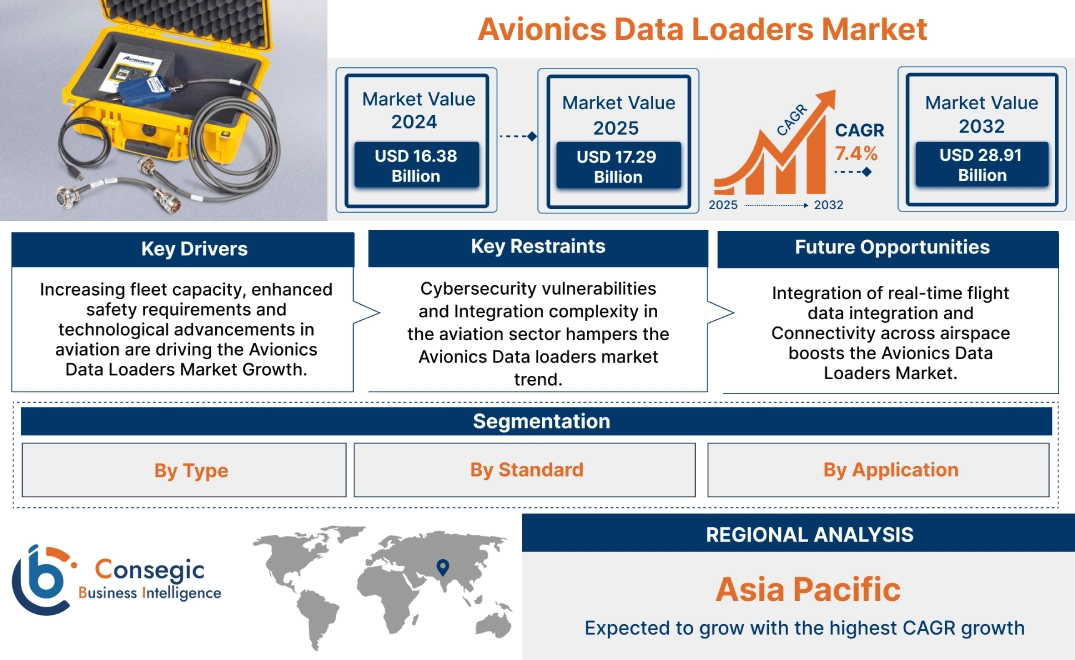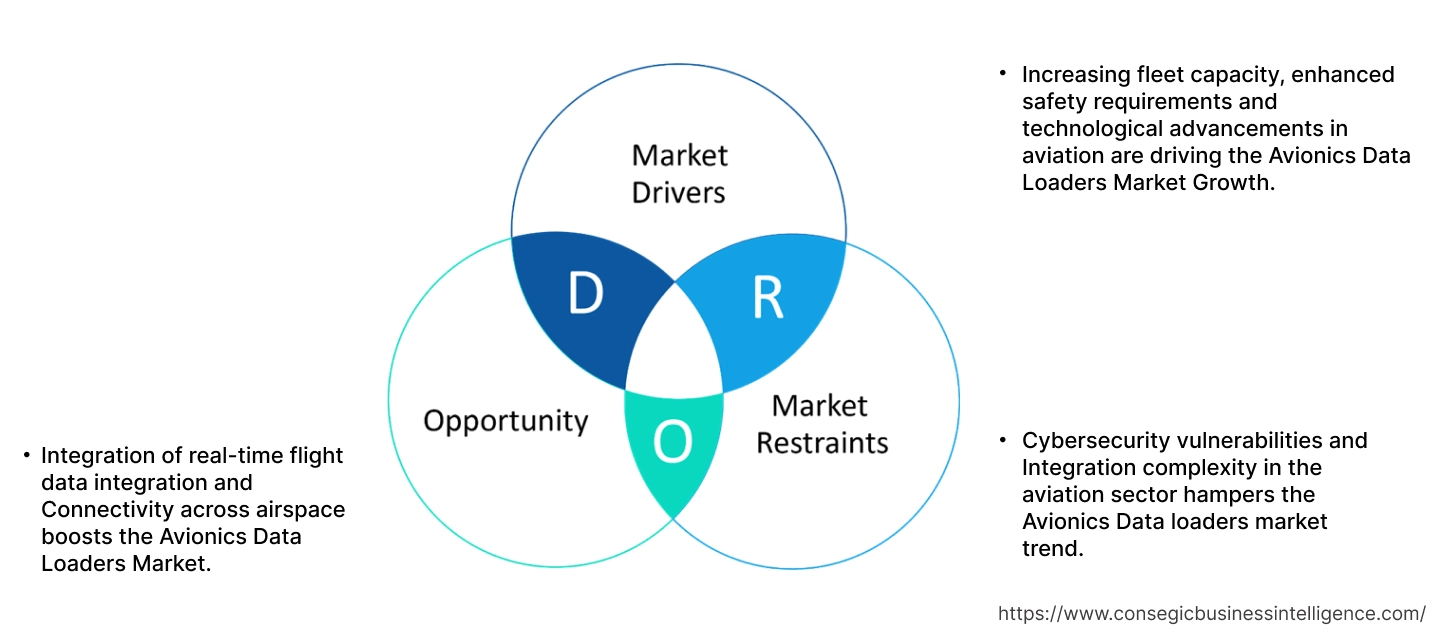- Summary
- Table Of Content
- Methodology
Avionics Data Loaders Market Size:
The Avionics Data Loaders Market size is estimated to reach over USD 28.91 Billion by 2032 from a value of USD 16.38 Billion in 2024 and is projected to grow by USD 17.29 Billion in 2025, growing at a CAGR of 7.4% from 2025 to 2032.
Avionics Data Loaders Market Scope & Overview:
A data loader is a tool that allows a user to upload new software parts on the embedded computers of an aircraft. The software part consists of executable code or data. Data loading requires a server containing the parts to be loaded and clients on each embedded computer to receive the part. The server can be located on an embedded computer on the aircraft or on an external computer that the maintenance crew brings to the aircraft. The server interacts with clients located on the aircraft via industry-defined protocols. Avionics data loaders are defined by a few different ARINC standards namely- ARINC 429, ARINC 665, ARINC 615, ARINC 615A. The ARINC 615A protocol is referred to as the Data Load Protocol (DLP) and it specifies the communications between an ARINC 615A Data Loader and the Avionics target device.
Avionics Data Loaders simplify the distribution, onboard storage and management of loadable software applications and databases across an airline's operation, by facilitating data transfer between ground-based computers and onboard avionics equipment. Their end-use industry for an is primarily commercial airlines and aircraft operators which needs to upload software updates or configuration data to an aircraft's avionics systems, including Maintenance, Repair, and Overhaul (MRO) providers and aircraft manufacturers themselves.
Key Drivers:
Increasing fleet capacity, enhanced safety requirements and technological advancements in aviation are driving the Avionics Data Loaders Market Growth.
The avionics data loaders market is primarily driven by the growing need for reliable data loading solutions to maintain and update advanced communication and navigation systems on increasingly networked aircraft, fueled by factors like expanding airline fleets, rising commercial flights, and a strong focus on improving safety and operational efficiency through software upgrades in the aviation sector.
Increase in number of commercial flights have resulted in the fleet capacity expansion which require significant system maintenance. This is possible with the help of a data loader which enables quick addition of new databases of different flights from the ground. Data loaders also include security measures to verify the integrity of software updates before loading them onto the aircraft. They provide robust mechanisms to protect against unauthorized data modifications or access.
- For instance, to meet the ever-growing need for increased connectivity and functionality to support today’s aircraft avionics operating via the Iridium SATCOM network, Collins’ ICS-300 SATCOM system offers significant enhancements from its predecessors, enabling truly global uninterrupted voice and data link coverage. This system includes additional ARINC 429 circuits, BITE processors and an ARINC 615 data loader for software updates and configurations.
Thus, the data loader improves the flight communication systems and flight software upgradation as the avionics technology advances leading to Avionics Data Loaders Market demand.
Key Restraints:
Cybersecurity vulnerabilities and Integration complexity in the aviation sector hampers the Avionics Data loaders market trend.
The primary restraints of an avionics data loaders include cybersecurity vulnerabilities and complex integration with existing aircraft systems. Both of these significantly impacts the safety and reliability of critical aircraft software updates loaded through the data loader.
Recent advances in avionics systems have made these data loaders more sophisticated and more connected but has also increased their exposure to cyber threats. The susceptibility of avionics buses to physical attacks on confidentiality, integrity, and availability, including Man-in-the-Middle attacks, where unauthorized interception and manipulation of data communication can occur is alarming and poses a severe risk to the aviation safety.
Integrating a data loader with existing avionics systems on an aircraft can be challenging due to the diverse hardware and software architectures, requiring extensive testing and validation to ensure compatibility. Different aircraft models and avionics systems may require customized data loaders, limiting the flexibility of a single device across various platforms.
Thus, these complexities and vulnerabilities deflate the trend of data loaders affecting the Avionics Data Loaders Market growth.
Future Opportunities:
Integration of real-time flight data integration and Connectivity across airspace boosts the Avionics Data Loaders Market.
Data sharing across an airline’s operational footprint helps crews identify maintenance issues before a breakdown. When real-time performance data is continuously shared with ground crews, they develop predictive schedules and anticipate issues to cut down on troubleshooting and downtime. Pilots also are able to see and avoid clear-air turbulence and real-time weather, improving on-time arrivals and traveler experience. Real-time data is crucial in today's high-demand travel environment, ensuring flight operations can accurately track flights within the airspace and receive alerts about conditions that could lead to costly flight deviations and unpleasant passenger experiences.
Connected aircraft enable efficiencies such as reducing fuel costs and emissions and improving operations. With real-time data accessible to management and operations, data-driven decisions are made to realize efficiencies, such as adjusting flight schedules and air-traffic-control priority. With data sharing, the entire system is optimized from gate tracking, flight optimization, crew and supporting team scheduling, and more. Airports have customer data, aircraft data, and airport operational data to analyze. Passenger experience from check-in and bag drop-off to off-boarding is enhanced based on data insights. As more aircraft take flight, connected systems will be critical for air traffic flow management.
Thus, these future integrations will boost the Avionics Data Loaders Market Opportunities.
Avionics Data Loaders Market Segmental Analysis :
By Type:
Based on type, the market is segmented into Airborne Data Loader (ADL) and Portable Data Loader (PDL)
The Portable Data Loader (PDL) segment accounted for the largest revenue in the avionics data loaders market share and is anticipated to have the highest CAGR during forecast period.
- Portable Data Loader, often abbreviated as PDL, represent indispensable tools within the aviation industry's operational infrastructure.
- These units serve a fundamental purpose in managing the intricate web of data that underpins modern aircraft avionics systems.
- Their primary function revolves around the seamless transfer of critical information between ground-based systems and avionics onboard aircraft.
- From uploading flight plans and navigational databases to facilitating software updates and performance data transfers, PDLs form the backbone of efficient data management within aviation operations.
- They are engineered for compatibility with a wide range of avionics systems and aircraft models, ensuring seamless integration across diverse fleets without encountering compatibility issues.
- For instance, in May 2024, FLYHT Aerospace Solutions (FLYHT) announced partnership with MBS Electronic Systems GmbH & Co. KG (MBS), a provider of secure data loading solutions that enable compliant avionics software maintenance and safer flight operations. The two companies collaborated to develop secure wireless avionics software and onboard portable data loading solution.
- Thus, according to market analysis, the Portable Data Loader is the most widespread used application, impacting the market trend.
By Standard:
Based on Standard, the market is segmented into ARINC 429, ARINC 615, ARINC 615A, ARINC 665.
The ARINC 615A segment accounted for the largest revenue share of 40.0% and is anticipated to have the highest CAGR during the forecast period in the Avionics Data Loaders market.
- ARINC-615A is the latest data loading standard update and describes the transfer of large data sets to and from next-generation avionics using high-speed ethernet interfaces.
- The ARINC 615A protocol is referred to as the Data Load Protocol (DLP) and it specifies the communications between an ARINC 615A Data Loader, which can be any computer with a network interface such as Ethernet and the avionics target device.
- Trivial File Transfer Protocol (TFTP), UDP and IP are used by ARINC 615A to provide network and file transfer services on the target to the Ethernet.
- Its advantages include recognition from certification authorities, compatibility with other systems, leverage towards standard networking protocols (Standard ethernet and support Wi-Fi data loading, ARINC-664, CAN Bus), and widespread supportability.
- For instance, In July 2024, Astronautics Corporation of America’s AeroSync Max wireless airborne communication system has been announced as the line-fit connectivity solution for Airbus’ new H160M helicopter; a multi-role, military rotorcraft derived from Airbus’ commercial H160. It facilitates easy upload of the field loadable software through ARINC 615A data loader function for maintenance of all equipment connected on Ethernet network.
- Thus, the use of ARINC 615A leads to the growth of Avionics Data Loaders Market.
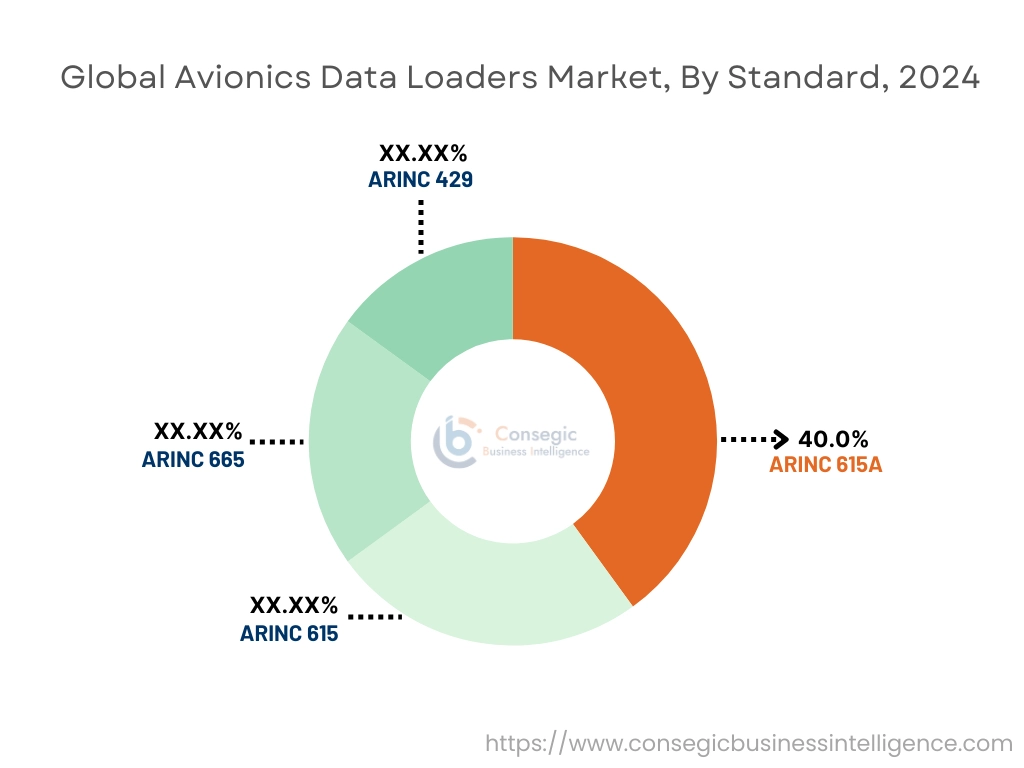
By Application:
Based on Application, the market is segmented into airlines, MROs, Avionics Equipment Supplier, Aircraft Manufacturers.
The airlines segment accounted for the largest revenue share and is anticipated to have the highest CAGR during the forecast period in the Avionics Data Loaders Market.
- A data loader is used in airlines to efficiently transfer data, like flight plans, navigation databases, and software updates, from ground-based computers onto an aircraft's onboard avionics systems.
- Primarily used to upload loadable software parts and critical data onto an aircraft's systems, including navigation information, performance calculations, and flight plans.
- It is used to significantly streamline the process and minimizing manual data entry, often referred to as an "Airborne Data Loader (ADL)" in aviation terminology.
- It acts as a bridge between ground systems and the aircraft's flight management computer and it reduces errors from manual data entry, enables quick and streamline data transfer, and ensures data accuracy.
- Thus, the surge in commercial flights is driving the Avionics Data Loaders Market.
Regional Analysis:
Asia Pacific region was valued at USD 4.82 Billion in 2024. Moreover, it is projected to grow by USD 5.11 Billion in 2025 and reach over USD 8.80 Billion by 2032. Out of this, China accounted for the maximum revenue share of 34.8%.
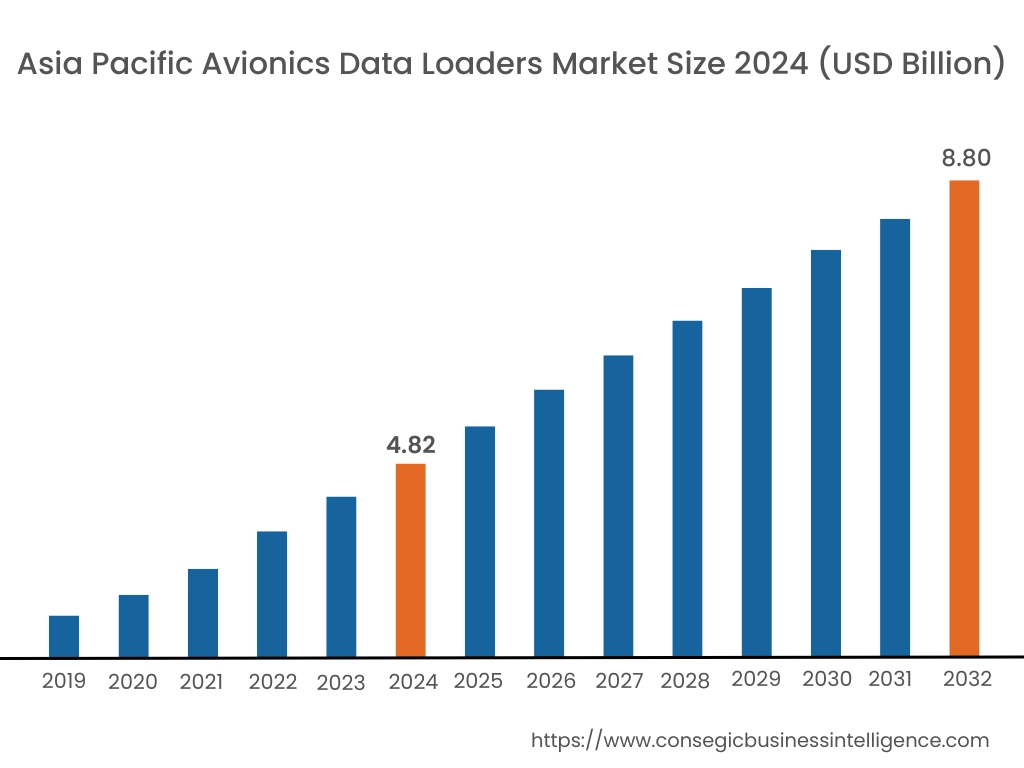
Asia Pacific region was valued at USD 4.82 Billion in 2024. Moreover, it is projected to grow by USD 5.11 Billion in 2025 and reach over USD 8.80 Billion by 2032. Out of this, China accounted for the maximum revenue share of 34.8%.
Asia Pacific is experiencing rapid growth in the trend of avionics data loaders market due to the expansion of commercial aviation, with increasing passenger traffic and new aircraft deliveries.
An aviation data loader in Asian region is used in the aviation sector to transfer data between various aircraft systems and ground computers, primarily for updating software, flight plans, and databases on airplanes, with a significant market growth currently seen across Asia Pacific due to the expanding airline fleets in countries like China, India, and Southeast Asia, due to the region's growing passenger traffic and need for new aircraft; additionally, military modernization efforts in several Asian nations drive demand for avionics data loaders for military aircraft as well. Growing airline fleets in countries like China and India are driving the need for data loaders to maintain and update aircraft systems.
Thus, according to the market analysis, it is a tool for managing and loading critical data onto aircraft within the region.
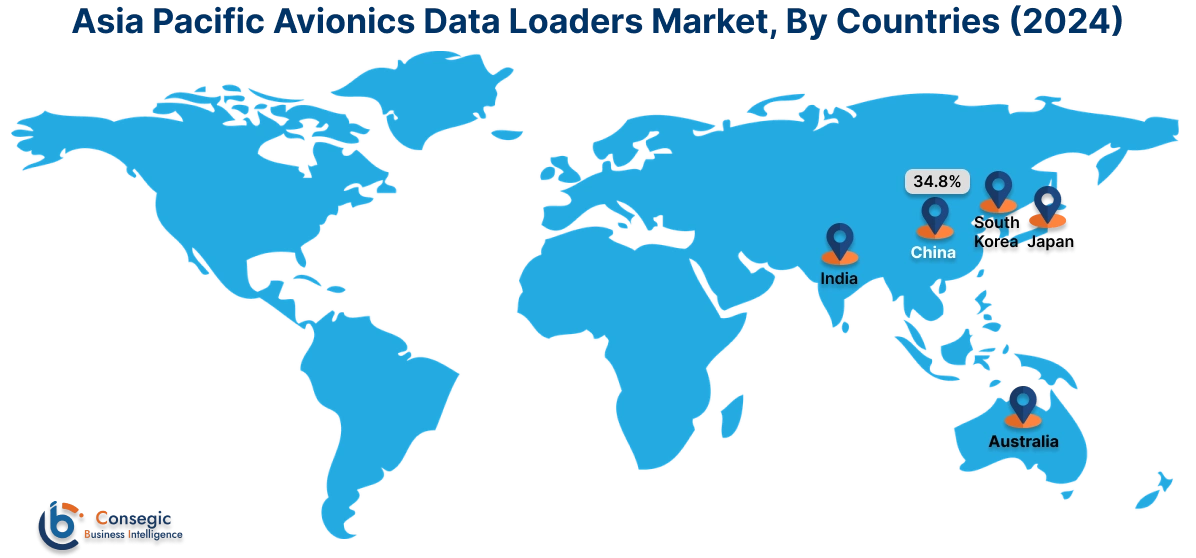
North America is estimated to reach over USD 9.37 Billion by 2032 from a value of USD 5.43 Billion in 2024 and is projected to grow by USD 5.73 Billion in 2025.
The North American region has the largest revenue share in the global Avionics Data Loaders Market. Data Loaders are primarily used to update and maintain the complex electronic systems (avionics) on aircraft, particularly within the military and commercial aviation sectors, ensuring their functionality and operational readiness by transferring critical data like navigation updates, software patches, and performance parameters directly to the aircraft systems; this is crucial for safe and efficient flight operations, with North America holding a significant market revenue due to its large fleet of aircraft and robust maintenance infrastructure.
In the United States, they are primarily used to transfer data between ground-based systems and an aircraft's avionics systems, allowing for updates to flight management systems, navigation databases, and other critical software on board, essentially facilitating the maintenance and modernization of aircraft systems by uploading new software and configurations, particularly within the commercial and military aviation sectors; this is crucial for ensuring operational readiness and safety across the US aircraft fleet.
Thus, the market analysis highlights the trend of data loaders in the North American region is boosting the Avionics Data Loaders Market.
In European countries, there has been a significant growth in avionics data loader’s market share as they are being used in data transfer such as flight plans, software updates, and configurations to an aircraft's avionics systems, with major players like Collins Aerospace, Thales, and L3Harris providing these solutions across various European nations, including France, Germany, UK, and Italy, where they often cater to aircraft manufacturers and airlines operating within the region; the data loading process is typically governed by standards like ARINC 615 and is crucial for aircraft maintenance and updates.
These devices facilitate the loading and downloading of data onto an aircraft, allowing for updates to navigation databases, performance calculations (like BADA - Base of Aircraft Data), and other critical systems. Much of the aviation data used in Europe comes from Eurocontrol, which aggregates data from commercial flights, radar systems, and air traffic management systems. European aviation data loaders often adhere to standards set by EUROCAE (European Organization for Civil Aviation Equipment), ensuring compatibility across different aircraft types and airlines.
Thus, the market analysis shows that the surge in trend of data loader across European countries drives their market demand in Avionics Data Loaders Market.
In the Middle East countries, Avionics data loaders are an emerging trend and is mainly used to upload and manage software and data onto aircraft avionics systems, with key countries in the region like the United Arab Emirates (UAE), Saudi Arabia, Qatar, and Egypt being prominent users due to their significant aviation industries and fleet modernization efforts; essentially, it's a tool used to update the complex electronic systems on aircraft operating within the Middle East region.
When considering African countries, it signifies the need for this technology to maintain and update the increasingly modern aircraft fleets operating across the continent, particularly as African airlines are modernizing and acquiring advanced aircraft, requiring efficient data loading capabilities to ensure optimal performance and safety standards.
Thus, the Avionics Data Loaders Market analysis highlights the growing demand of Data loaders in Middle East and African countries.
In Latin American region these devices are an emerging trend with a lot of growth potential. They are used to upload software and configuration data to an aircraft's avionics systems, specifically within the region's aviation sector, with major players like Collins Aerospace providing support and sales solutions across South American countries like Brazil and Chile; it is a tool for updating critical aircraft systems with necessary information through a dedicated interface.
Therefore, the market analysis shows the emerging progression of data loaders and aviation technologies in the Latin American region leading to future opportunities.
Top Key Players & Market Share Insights:
The Avionics Data Loaders market is highly competitive with major players providing products and services to the national and international markets. Key players are adopting several strategies in research and development (R&D), product innovation, and end-user launches to hold a strong position in the global Avionics Data Loaders market. Key players in the Avionics Data Loaders industry include –
- Honeywell Avionics (US)
- Astronics (US)
- MBS Electronic Systems (Germany)
- AIM (Germany)
- Universal Avionics (US)
- Collins Aerospace (US)
- Teradyne (US)
- Teledyne Technologies (US)
- L3Harris Technologies (US)
- TechSAT GmbH (Germany)
Recent Industry Developments :
- In November 2024, Teledyne Controls, a subsidiary of Teledyne Technologies and a leading provider of innovative avionics and aircraft data management solutions, announced that its new onboard enhanced Airborne Data Loader has received certification for use on the Boeing 737NG aircraft series.
Avionics Data Loaders Market Report Insights:
| Report Attributes | Report Details |
| Study Timeline | 2019-2032 |
| Market Size in 2032 | USD 28.91 Billion |
| CAGR (2025-2032) | 7.4% |
| By Type |
|
| By Standard |
|
| By Application |
|
| By Region |
|
| Key Players |
|
| North America | U.S. Canada Mexico |
| Europe | U.K. Germany France Spain Italy Russia Benelux Rest of Europe |
| APAC | China South Korea Japan India Australia ASEAN Rest of Asia-Pacific |
| Middle East and Africa | GCC Turkey South Africa Rest of MEA |
| LATAM | Brazil Argentina Chile Rest of LATAM |
| Report Coverage |
|
Key Questions Answered in the Report
What are Avionics Data Loaders? +
Avionics data loaders are tools that allows users to upload new software parts on the embedded computers of an aircraft. It requires a server containing the parts to be loaded and clients on each embedded computer to receive a part. The server interacts with clients located on the aircraft via industry-defined protocols.
What are the major drivers of market growth? +
Increasing fleet capacity, enhanced safety requirements and technological advancements in aviation are the major drivers of the Avionics Data Loaders market. Data Loaders are used for high system maintenance due to the rise in daily commercial flights, providing safety and security measures for the integrity of software updates.
What specific segment details are covered in the Avionics Data Loaders Market report, and how is the dominating segment impacting market growth? +
The Avionics Data Loaders Market is segmented on the basis of Type, Standard, and Application and are further divided into sub segments. For instance, the ‘By Standard’ segment further constitutes ARINC 429, ARINC 615, ARINC 615A, and ARINC 665, in which ARINC 615A is the dominating segment due to it being the latest data loading standard update having the capabilities of transferring large data sets using high-speed interfaces.
Who are the major key players in the Avionics Data Loaders market? +
Honeywell Avionics (US), Astronics (US), Collins Aerospace (US), Teradyne (US), Teledyne Technologies (US), L3Harris Technologies (US), TechSAT GmbH (Germany), MBS Electronic Systems (Germany), AIM (Germany), Universal Avionics (US).
